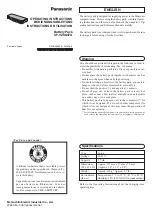
42
43
Installation and Operating Manual
sun |
powerpack
classic
7140803000 V1.1 (10.2015)
Installation and Operating Manual
sun |
powerpack
classic
7140803000 V1.1 (10.2015)
14. Connect the central degasification systems of the battery blocks (black diaphragm valve near
the plus terminal) with the help of the PVC hosepipe supplied and the associated T and L pie-
ces with one another starting from the right side. Begin with one L piece at the block battery
on the right border of the carrier.
15. Cut the PVC hosepipe to appropriate size and connect it with the L piece. Then insert the T
piece into the black diaphragm valve of the central degasification system of the next block
battery. At the other end of the T piece, connect the PVC hosepipe with the next T piece.
Continue with this procedure until all batteries have been connected to one another (see
Figure 6).
Figure 6: Example of central degasification
16. Fix the condensate separator
1
with cable ties at the bottom left to the carrier (see Figure 7).
Connect the end of the PVC piping of the block batteries with the inlet opening of the con-
densate separator.
The inlet opening of the condensate separator is connected with a longer PVC hosepipe within
the housing and the outlet opening with a shorter one. The inlet and outlet openings should not
be interchanged!
Figure 7: Condensate separator fixed to the carrier
17. Cut another approx. 5 cm long piece of PVC hosepipe to size and connect it with the outlet
opening of the condensate separator. Guide the end of the PVC hosepipe through the opening
and out of the carrier.
1 Since even with sealed batteries, under extreme operating conditions, acid particles (so-called acid aerosols) may leak out, the condensate
separator is used to protect the end user against acid aerosols.
18. Fix the cable glands supplied along with the battery to the left side of the carrier and pointing
inwards (see Figure 8). Fix the cable glands with the locknuts.
Figure 8: The upper level of the carrier with cable glands
7.1.1 Installing the second battery carrier
The following explanations pertain only to the
sun |
powerpack
classic
systems 16.0/48 and
22.0/48 in conjunction with a charger or power inverter:
1. Carry out the installation steps 1-3, 8-11 and 14-17 of section 7.1 on the second battery
carrier.
2. Place two cable glands at the through boreholes that are still open on the first battery carrier.
The remaining two cable glands must be fixed on the left side of the second battery carrier.
3. Guide the cable set (2 m marked red and 24 m marked black) through the cable glands from
the first carrier to the second one.
4. Connect the cables to the flat terminals of the fuse-protected isolator switch on the first carrier.
It must be ensured that the upper and lower cable lugs are connected the other way round to
each other (see Figure 5). Pay attention to correct polarity and the tightening torque required.
5. Connect the cable set with the help of the terminal screws on the side of the plastic insulated
cable lugs to the plus and minus system poles of the second battery carrier.
6. Tighten the inserted cable glands in order to ensure strain relief for the connecting cable.
7.2 Installing the battery carrier for use with multiple chargers/power inverters
The following explanations pertain only to the
sun |
powerpack
classic
systems 16.0/48 and
22.0/48 in conjunction with multiple chargers or power inverters.
1. Carry out the installation steps 1-3, 8-11 and 14-18 of section 7.1 on both battery carriers.
2. Install the
sun |
fusebox as per section 4 of the accompanying installation instructions. Mind
the required safety distance.
3. Take both 2.5 m long, 95 mm
2
cable sets and insert them through the left cable screw con-
nectors and into the carrier.
4. Connect the positive and negative terminals of both
sun |
fusebox systems to the copper rails
of the
sun |
fusebox. Use the provided M8 stainless steel screws with washers and the spring
washers on the battery side. Follow the installation instructions of the
sun |
fusebox.
















































